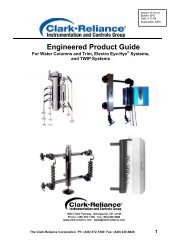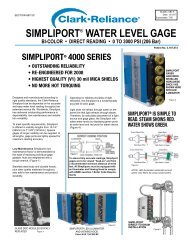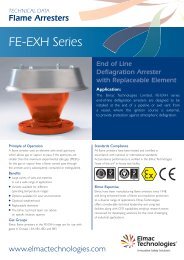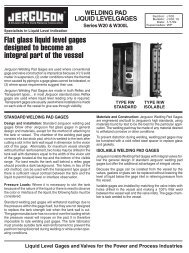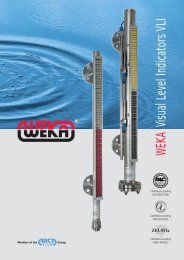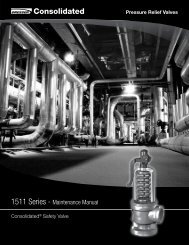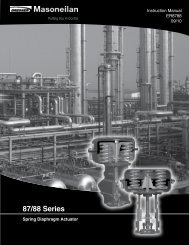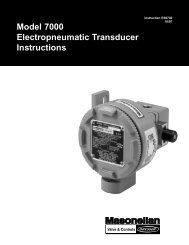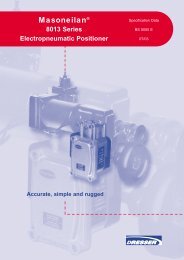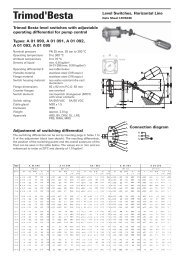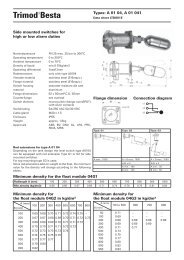1900 Series - Maintenance Manual
1900 Series - Maintenance Manual
1900 Series - Maintenance Manual
You also want an ePaper? Increase the reach of your titles
YUMPU automatically turns print PDFs into web optimized ePapers that Google loves.
XIII. Setting and Testing (Contd.)Set Pressure (60°F or 15.6°C)(psig)Pressure(barg)Table 17: Valve Leakage Rate (Metal Seat)Valve Orifice D & EValve Orifice F and LargerApproximate Leakage per 24 hrs Approximate Leakage per 24 hrsLeakage Rate(Bubbles perMinute)ft 3 m 3 (Bubbles perLeakage RateMinute)ft 3 m 315-1000 1.03-68.95 40 0.6 0.02 20 0.3 0.011500 103.42 60 0.9 0.03 30 0.45 0.012000 137.90 80 1.2 0.03 40 0.6 0.022500 172.37 100 1.5 0.04 50 0.75 0.023000 206.84 100 1.5 0.04 60 0.9 0.034000 275.79 100 1.5 0.04 80 1.2 0.035000 344.74 100 1.5 0.04 100 1.5 0.046000 413.69 100 1.5 0.04 100 1.5 0.04for valves on inlet sizes through 2˝ (50.8 mm); 2minutes for sizes 2.5˝ (63.5 mm), 3˝ (76.2 mm) and4˝ (101.6 mm), and 5 minutes for the 6˝ (152.4 mm),8˝ (203.2 mm), 10˝ (254 mm) and 12˝ (304.8 mm)sizes. For metal-to-metal valves designated forgaseous service, the leakage rate shall not exceedmaximum bubbles per minute (see Table 16).2. Check that there is no visible leakage for valvesdesignated for steam service (and tested on steam)or for liquid service (and tested on water).Seat Tightness Testingfor O-Ring Seat Seal ValveThe tightness standard for O-ring seat seal valves shallbe no leakage at or below the test pressures listed (seeTable 18).Table 18: Leakage Rate (Soft Seat)Set Pressure Test Pressure (1)(psig) (barg) (psig) (barg)3 2.07 1.5 1.034 2.76 2 1.385 3.45 2.5 1.726 4.14 3 2.077.0 – 14.0 4.83 – 9.65 3.0 below Set 2.07 below set15.0 – 30.0 10.34 – 20.68 90% of Set 90% of Set31.0 – 50.0 22.06 – 34.47 92% of Set 92% of Set51.0 – 100.0 35.16 – 68.95 94% of Set 94% of SetSet > 100.0 Set > 68.95 95% of Set 95% of Set1. Set pressures below 15 psig are outside the scope of API 527.Recommended BackpressureTesting for Joint LeakageIf the valve is to be used in a closed discharge system,backpressure-test the valve after it has been set for thecorrect opening pressure. Conduct testing by installingthe screwed cap (21) with a cap gasket (27) andapplying air or nitrogen to the base drain connection orto the valve outlet. Seal all other openings.Test pressure should be the greater of 30 psig (2 barg)or the actual valve backpressure. Hold air or nitrogenpressure for 3 minutes before applying leak detectorsolution to all connections (joints).On bellows valves, hand-tighten a clean pipe plug in thebonnet vent connection in order to obtain the smallestpossible leak path. Remove this plug after the test.Apply liquid leak detector to the following SRV componentsand examine for leakage during backpressure testing:• Nozzle/base joint.• Adjusting ring pin seal.• Base/bonnet joint.• Bonnet/cap joint.• “Tight” bonnet vent plug, if conventional valve.• “Loose” bonnet vent plug, if bellows valve.Gag the safety valve duringring adjustments to avoidpossible severe personalinjury or death.48 | Dresser Consolidated ®



